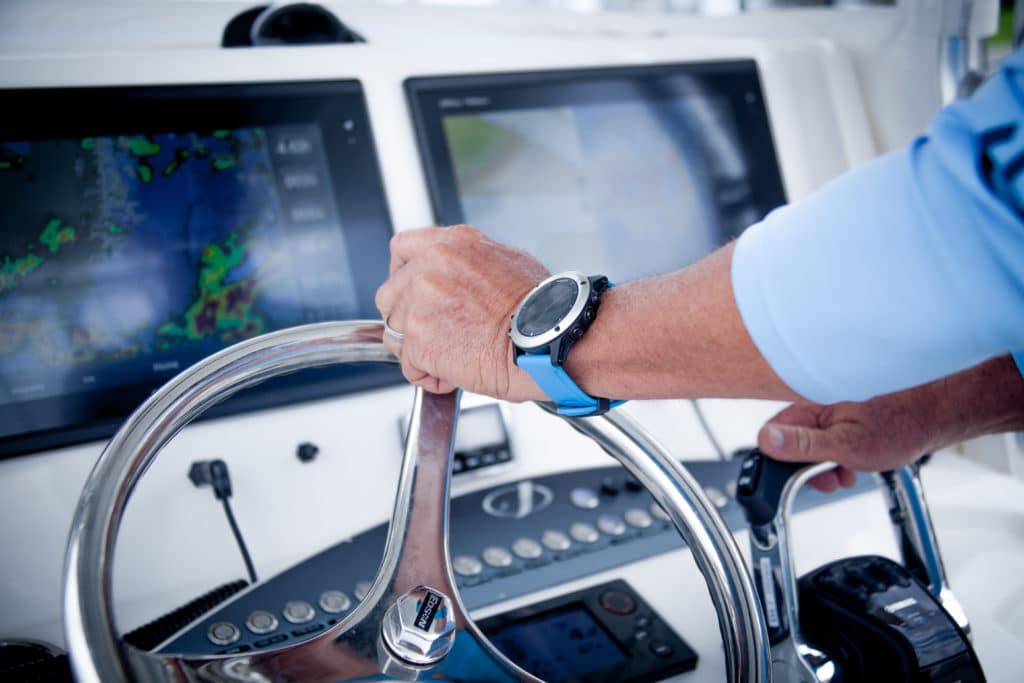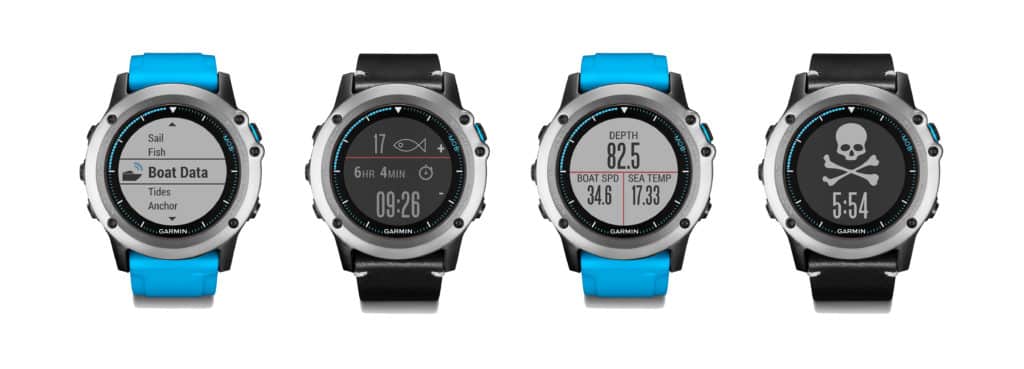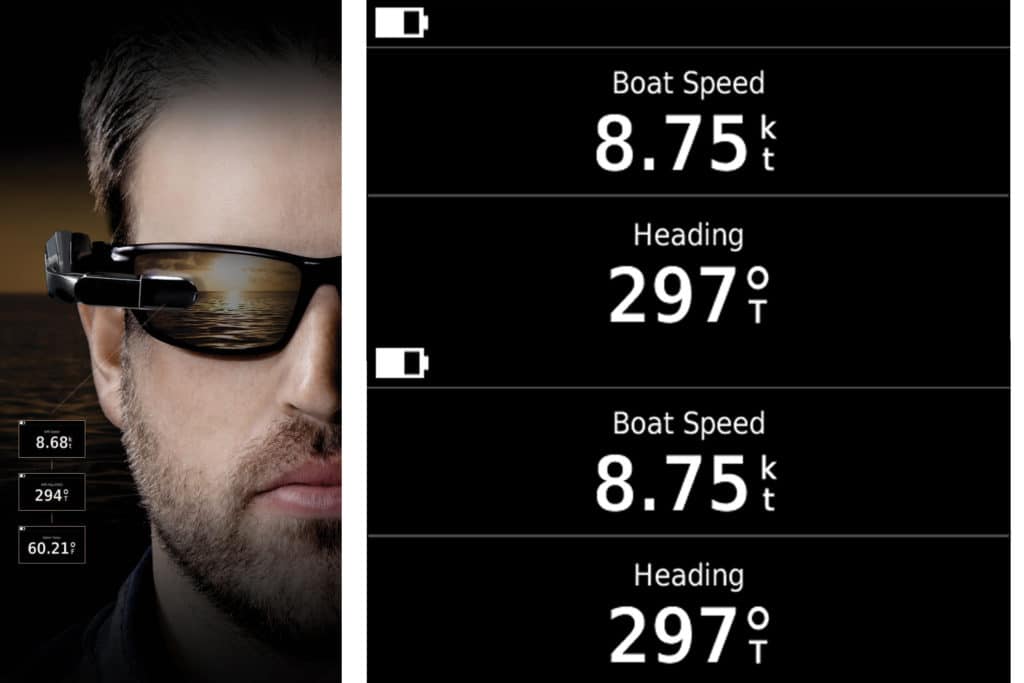
Irrespective of one’s proclivity for onboard technology, there’s no denying the sea change that smartphones and tablets have brought to marine electronics. Thanks to their built-in GPS receivers, plentiful processing power, touch-screen graphical interfaces and cellular modems, these devices are virtually tailor-made for use as independent navigation systems when loaded with the right cartography app, and provided, of course, that cellular or Wi-Fi service exists. I clearly remember the first few times that I used a Navionics chart app while sailing, amazed that I could privately explore alternative routings without causing agita at the nav station.
But while everyone’s abuzz about their phone and iPad, a new generation of wearable technology has been quietly gathering speed and now offers sailors hands-free access to critical data, anywhere on the boat.
Although many of us sail to escape onshore white noise, wearable technology delivers the benefit of increased situational awareness and onboard mobility sans the need to install a bevy of repeater screens. Also, by having constant access to metrics such as speed over ground and apparent wind angle, it’s much easier to qualify and quantify the real-time effects of sail trim and steering on your estimated time of arrival. Here, then, is a look at what’s out there in the world of wearables and how these devices work.
Let’s start at the wrist. Most sailing watches fall into one of two camps: digital chronometers with regatta-specific timers and countdown alarms, or upscale and elegant horological pieces with mechanical movements and wallet-puckering price tags. Garmin started innovating in this space in 2013 with the launch of its first-generation quatix GPS-enabled smartwatch, which offered what the company termed solid-state “ABCs” — altimeter, barometer and compass — along with handy sailing-specific features, such as a man-overboard button and tide information.
In stand-alone mode, quatix could use its onboard sensors and its GPS receiver to determine speed, direction and position information. The watch’s built-in Wi-Fi, Bluetooth and ANT+ (a communications protocol commonly used by fitness and other monitoring devices) connectivity allowed it to be paired with Garmin’s GNT-10 NMEA transceiver to display information from the vessel’s navigation system. Cooler still, quatix could be used to control a compatible Garmin autopilot.
“The first quatix was ahead of its time,” says Dave Dunn, Garmin’s director of marine sales and marketing, who explained that quatix’s ability to control autopilots earned it the nickname “the James Bond watch” among timepiece enthusiasts, of which he is one. “It was big and bulky, but it put quatix on the map.”

Today, all the major marine-electronics manufacturers include Wi-Fi and Bluetooth capability in their higher-end chart plotters, allowing smart devices to wirelessly talk to the plotter and access navigation and other data carried over an NMEA 2000 network.
“We live in a connected world,” says Dunn as he describes the considerably sleeker quatix 3, which was released in 2016 and allows users to customize their watch-face setting to display a range of onboard data. “One of quatix 3’s only shortcomings is that there’s no autopilot control,” says Dunn. The autopilot-control feature, he explains, didn’t mesh well with the new watch’s software platform; this may be corrected, though, in the next-generation quatix.
Still, quatix 3 is loaded with sailing-specific features, including a stand-alone man-overboard button that sets an internal emergency waypoint. The watch can also be paired with smartphones and tablets to access the Internet, and with a free app, it can be used to control an onboard Fusion marine stereo.
For most cruising sailors, basic depth and speed are top of mind when considering what metrics to have on display. But Garmin borrowed a page from the smartphone and tablet developers’ handbook and gives the quatix user lots of options. Garmin and third-party apps are available for download from the company’s Connect IQ online store. Additionally, built-in software allows quatix 3 owners to create and store up to 1,000 waypoints and 30 routes — a tool that could prove useful when searching a dark harbor for the boat after a big night ashore.
As with all portable electronics, quatix watches are beholden to their batteries, which in this case are USB-rechargeable lithium-ions. A quatix 3 can go for 30 days before needing a DC top-off, says Dunn, so long as its power-thirsty GPS receiver is switched off. To save juice, Dunn recommends pairing quatix watches with compatible chart plotters to obtain position and speed information, as this draws significantly less power than using the device’s internal resources.
Third-party connectivity is a limitation for quatix and quatix 3 because they can only be paired with Garmin-built chart plotters and wind instruments. Still, the watches’ impressive navigational capabilities when operating in stand-alone mode, coupled with their easy-to-read graphics and rugged, waterproof (to 150 feet) construction, make them solid choices for sailors of all stripes.
Another player in this segment of the wearable market is Italy’s Astra Yacht, which touts its esa Watch as the world’s first Android-based sailing timepiece. It features a touch-sensitive, customizable 1.54-inch high-definition screen that can display a wide range of performance and navigation data. Built-in Wi-Fi and Bluetooth connectivity allow the watch to connect to your boat’s navigation and other systems via Astra Yacht’s GAMP 2000 Wi-Fi multiplexer, which is sold separately. Users can download apps from the Google Play store, and paired with a smartphone, the watch can be used to make phone calls, send and receive text messages and email, play music and browse the Web. If connectivity doesn’t exist, the watch can use its internal GPS receiver to calculate speed and heading information.
Apple Watch wearers can join the fun too, with a range of sailing-specific apps available to let them seamlessly mesh their time on the water with all the other aspects of their digital lives.
Heads-Up Info

Rather than putting information on your wrist, head-up displays, or HUDs, take an in-your-face approach to keeping you on top of critical data. The technology became famous in the sailing world when Oracle Team USA’s skipper Jimmy Spithill used a custom-built system to win the 34th America’s Cup in 2013.
At present, just two companies make HUDs for multiple recreational outdoor activities: Garmin, which originally created a product for cyclists, and Recon, which targeted skiers and snowboarders but has since expanded into other sports, such as running and cycling.
So far, Garmin is the only manufacturer with sailing-specific gear, its Nautix in-view display. Recon has not launched a marine-specific product, though Canadian firm Afterguard made headlines in 2014 with the news that it has a sailing-specific display using Recon hardware. Afterguard did not respond to correspondence related to this article.
Garmin’s Nautix is a small, 1.1-ounce device that clips onto the temple of most glasses or sunglasses (excluding those with wire frames), making it an especially attractive option for sailors who use prescription glasses. These tidy displays wirelessly talk to a compatible Garmin chart plotter via an ANT+ connection, which allows Nautix to display networked NMEA 2000 data. A glove- and water-friendly touch-screen strip that’s fitted along the display’s chassis allows users to scroll between five customizable screen views.
“Cruisers who are away from their helms can keep an eye on their data,” says Dunn. Nautix can display need-it-now metrics, including boat speed, depth, heading, wind direction and bearing to the next waypoint, all on a screen that offers 428-by-240-pixel resolution, which delivers sharp, crisp graphical imagery.
As with anything new that’s introduced into your field of vision, it can take a few moments to initially adjust your eyes to the presence of the display, but after a brief learning curve Nautix’s screen is unobtrusively there, offering pertinent information without compromising one’s sight.
For performance–oriented sailors this can be a great tool to help get the most from their boat and sails. An ambient light sensor embedded in the Nautix display even dynamically adjusts for passing clouds and sunset.
Unlike quatix watches, Nautix displays can’t function in a stand-alone mode, making them only suited for use aboard Garmin-equipped boats.
While the luddites among us can make a strong argument for using sailing to escape the all-info clutter that assaults us ashore, wearable technology offers a digitally stylish way of staying up-to-date on dynamic information, and it can also be a great new way to learn more about how your boat responds to different sail-trim and steering inputs. Just be forewarned: Chasing numbers on the speedo can be addictive and lead to some expensive — but rewarding — conversations with your sailmaker.
David Schmidt is CW’s electronics editor.








